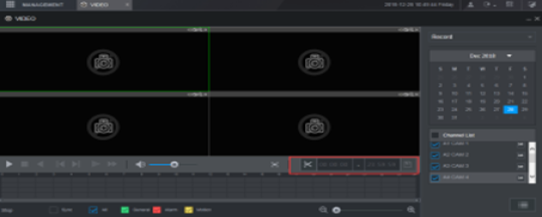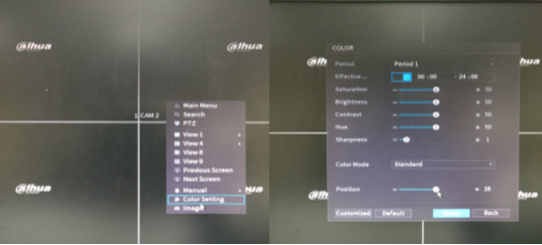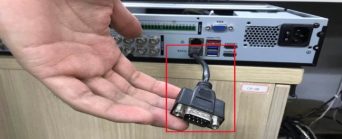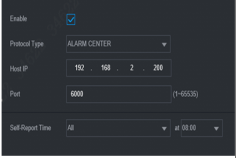Dahua HDCVI Recorder (XVR) FAQ, Dahua HDCVI (High Definition Composite Video Interface) Recorders include the Ultra, Pro, and Lite Series to fit various applications. Ultra Series recorders offer the best performance and highest quality. Pro Series devices are perfect for mid-large size businesses and projects which require a balance between performance and budget. Lite Series recorders are designed for optimum cost performance with Dahua quality assurance standard.
HDCVI Recorders, as a part of an HDCVI system, are widely used in applications where existing infrastructure is available and users have a need for the latest technologies like 4MP/4K resolution, IoT over coax, Power over Coax (PoC), and more. As the inventor of HDCVI technology, Dahua is committed to bringing the latest technologies to existing coax-based systems, enabling users to enjoy the latest innovations and industry developments.
Video #
A: Characters seen in the local live interface are different from the sources in the code. OSD characters in the code are added by the device, and the size and front are fixed when they are added. But after the characters are added to streams with different resolutions, they will be different after being zoomed into the quad split screen.
.
A: The collected frame rate is 7 when XVR7-4KL-X connects with 4K camera, even if you change the encoding resolution, the number of collected frame will not increase. You can go to the OSD interface to change the corresponding resolution of the front-end device; for example, if you change the front-end to 4MP, the number of frames in the back-end could be changed to 15 frames, and so on.
.
A: The idealized playback speed is 1/16 -16x, but the actual playback multiple will be limited by network performance. For example, for 1 channel of 1080P 4Mbps stream with a speed of 16x, the network bandwidth requires 64Mbps; if the network environment is poor, the actual playback speed will be affected.
.
A: 960H. 720P and 1080P can be customized.
.
A: Performance limit. For 265 low-slot devices, 2K/4K and spot functions on VGA are mutually exclusive.
.
A: No, only analog channels.
.
A: If the default resolution of the Motion Detect is 720P and that of the normal screen is 1080p, when a person is detected, the screen will automatically switch to 720p, resulting in the screen zoomed out and the person out of the screen. It will be normal when you change the Motion Detect resolution to 1080p.
.
A: Most likely because unstable HDCVI cable contact causes imbalance of the HDCVI signal.
.
A: When editing the video, you need to click the scissors button twice to confirm the clip period.
The first period: Select the current play time or click on the timeline as the start time.
The second period: Click on the timeline again to play the video during other time, and click the scissors button to take the current play time.
.
.
A: Right click on the local live interface to select the Color Setting, and adjust the progress bar of the Position.
Recording #
A: It’s normal and you can close it manually.
.
A: Possible causes:
.
A: Possible causes:
.
A: Possible causes:
.
IPC Connection #
A: Solutions:
.
.
External Device #
A: Currently, the DMSS version does not support this function. It is expected that the version released in 2019 will enable the function. The current version can only display the alarm output port Information that comes with the device itself.
.
A: Both are supported, and this is not related to XVR but a general function, as long as it is supported by the tripartite protocol.
.
A: Usually, the device audio input must be active, namely, the audio collector has power supply. When this condition is met, if the output is normal when the pickup is directly connected to the speaker, but there is a big noise when it is connected to the XVR, you need to replace the transmission cable; for example, the Cat5e twisted pair with the Cat6 twisted pair.
.
.
Others #
A: Fans of H265 devices (expect for model E) are blowing in. The reason is that it is more effective for heat dissipation.
.
A: Because these browsers Is unavailable for NPAPI (security issues) technical support, and do not load the controls of our device. It is recommended to use the IE browser and WIN 7 system.
.
A: When the HDCVI back-end device has problems such as no image in the channel, unstable image and blurred screen, after troubleshooting by a cross test, the initial diagnosis is a back-end problem. Most likely AD chip hardware of the channel is damaged, and the causes for this damage are generally as follows:
.
A: Power on while pressing and holding the hardware reset button, and release the button after about 10s.
.
A: HD-CVI refers to the protocol for coaxial control of CVI made by Dahua (it supports all functions of CVI, including coaxial control, dome camera and PTZ control). HD-CVI 2.0 is used for products manufactured by other manufacturers using the HDCVI chip (it only supports basic commands such as menu callout, up and down, left and right; it does not support more detailed commands such as dome camera control and preset position); HDCVI3.0 adds coaxial control for TVI and AHD protocol on the basis of HD-CVI.
.
A: HDCVI and CVBS
.
A: 128, and the transmission bandwidth of the device is 384Mbps.
.
A: Different standards are used, so it is incompatible.
.
A: Go to Main Menu > System > PTZ Setting interface of XVR, and set as follows: Select a channel number, change the control mode to Coaxial, and change the protocol to DH-SD1 or HDCVI, then apply them, and go to the PTZ control to click aperture +.
.
A: Currently, this function is unavailable for customers. The upgrading should be made by R&D as customized programs.
.
A: 300,000.
.
A: 75 ohms
.
A: As shown in illustration. A serial port-to-network port cable is necessary.
.
.
A: Coaxial cable 75-3 or 75-5. Try to fix the shielding layer and coaxial core tightly to avoid short circuit when twisting.
.
A: Audio input: 10K ohm, audio output: 1K ohm, Mic input: multiplex with audio input, Mic output: multiplex with audio output.
Dahua HDCVI Recorder (XVR) FAQ #
A: This protocol is used for dynamic IP scenes of Dahua devices in WIFI or 4G environment (Protocol role: When it is used to connect to the tripartite platform, in order to monitor the server role. The tripartite platform waits for the alarm Information of the Dahua device, the Dahua device sends connections to the SDK, and the SDK releases TCP connection and listening). After the event Information is successfully sent, the device closes the TCP connection.











